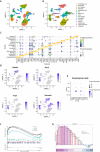Exosomes originating from neural stem cells undergoing necroptosis participate in cellular communication by inducing TSC2 upregulation of recipient cells following spinal cord injury
- PMID: 38993124
- PMCID: PMC11881710
- DOI: 10.4103/NRR.NRR-D-24-00068
Exosomes originating from neural stem cells undergoing necroptosis participate in cellular communication by inducing TSC2 upregulation of recipient cells following spinal cord injury
Abstract
JOURNAL/nrgr/04.03/01300535-202511000-00030/figure1/v/2024-12-20T164640Z/r/image-tiff We previously demonstrated that inhibiting neural stem cells necroptosis enhances functional recovery after spinal cord injury. While exosomes are recognized as playing a pivotal role in neural stem cells exocrine function, their precise function in spinal cord injury remains unclear. To investigate the role of exosomes generated following neural stem cells necroptosis after spinal cord injury, we conducted single-cell RNA sequencing and validated that neural stem cells originate from ependymal cells and undergo necroptosis in response to spinal cord injury. Subsequently, we established an in vitro necroptosis model using neural stem cells isolated from embryonic mice aged 16-17 days and extracted exosomes. The results showed that necroptosis did not significantly impact the fundamental characteristics or number of exosomes. Transcriptome sequencing of exosomes in necroptosis group identified 108 differentially expressed messenger RNAs, 104 long non-coding RNAs, 720 circular RNAs, and 14 microRNAs compared with the control group. Construction of a competing endogenous RNA network identified the following hub genes: tuberous sclerosis 2 ( Tsc2 ), solute carrier family 16 member 3 ( Slc16a3 ), and forkhead box protein P1 ( Foxp1 ). Notably, a significant elevation in TSC2 expression was observed in spinal cord tissues following spinal cord injury. TSC2-positive cells were localized around SRY-box transcription factor 2-positive cells within the injury zone. Furthermore, in vitro analysis revealed increased TSC2 expression in exosomal receptor cells compared with other cells. Further assessment of cellular communication following spinal cord injury showed that Tsc2 was involved in ependymal cellular communication at 1 and 3 days post-injury through the epidermal growth factor and midkine signaling pathways. In addition, Slc16a3 participated in cellular communication in ependymal cells at 7 days post-injury via the vascular endothelial growth factor and macrophage migration inhibitory factor signaling pathways. Collectively, these findings confirm that exosomes derived from neural stem cells undergoing necroptosis play an important role in cellular communication after spinal cord injury and induce TSC2 upregulation in recipient cells.
Copyright © 2025 Neural Regeneration Research.
Conflict of interest statement
Figures






Similar articles
-
Intravenous Administration of Mesenchymal Stem Cell-Derived Exosome Alleviates Spinal Cord Injury by Regulating Neutrophil Extracellular Trap Formation through Exosomal miR-125a-3p.Int J Mol Sci. 2024 Feb 18;25(4):2406. doi: 10.3390/ijms25042406. Int J Mol Sci. 2024. PMID: 38397083 Free PMC article.
-
IPSC-NSCs-derived exosomal let-7b-5p improves motor function after spinal cord Injury by modulating microglial/macrophage pyroptosis.J Nanobiotechnology. 2024 Jul 9;22(1):403. doi: 10.1186/s12951-024-02697-w. J Nanobiotechnology. 2024. PMID: 38982427 Free PMC article.
-
Insulin-like growth factor-1 enhances neuroprotective effects of neural stem cell exosomes after spinal cord injury via an miR-219a-2-3p/YY1 mechanism.Aging (Albany NY). 2019 Dec 17;11(24):12278-12294. doi: 10.18632/aging.102568. Epub 2019 Dec 17. Aging (Albany NY). 2019. PMID: 31848325 Free PMC article.
-
Role of Stem Cell-Derived Exosomes and microRNAs in Spinal Cord Injury.Int J Mol Sci. 2023 Sep 8;24(18):13849. doi: 10.3390/ijms241813849. Int J Mol Sci. 2023. PMID: 37762150 Free PMC article. Review.
-
Therapeutic Potential of Mesenchymal Stem Cell-Derived Exosomes in Spinal Cord Injury.Mol Neurobiol. 2025 Jan;62(1):1291-1315. doi: 10.1007/s12035-024-04490-0. Epub 2024 Sep 23. Mol Neurobiol. 2025. PMID: 39312070 Review.
Cited by
-
Exosomes: a promising microenvironment modulator for spinal cord injury treatment.Int J Biol Sci. 2025 Jun 5;21(8):3791-3824. doi: 10.7150/ijbs.115242. eCollection 2025. Int J Biol Sci. 2025. PMID: 40520019 Free PMC article. Review.
-
Harnessing stem cell-derived exosomes: a promising cell-free approach for spinal cord injury.Stem Cell Res Ther. 2025 Apr 17;16(1):182. doi: 10.1186/s13287-025-04296-4. Stem Cell Res Ther. 2025. PMID: 40247394 Free PMC article. Review.
-
Cuproptosis: a novel therapeutic mechanism in lung cancer.Cancer Cell Int. 2025 Jun 24;25(1):231. doi: 10.1186/s12935-025-03864-1. Cancer Cell Int. 2025. PMID: 40555995 Free PMC article. Review.
-
Down-regulation of neuregulin2 (NRG2) following spinal cord injury in C57BL/6 mice: Its implications in therapeutic potential.Iran J Basic Med Sci. 2025;28(8):1075-1081. doi: 10.22038/ijbms.2025.83787.18131. Iran J Basic Med Sci. 2025. PMID: 40584443 Free PMC article.
References
-
- Browaeys R, Saelens W, Saeys Y. NicheNet: modeling intercellular communication by linking ligands to target genes. Nat Methods. 2020;17:159–162. - PubMed
-
- Chen N, Zhou P, Liu X, Li J, Wan Y, Liu S, Wei F. Overexpression of rictor in the injured spinal cord promotes functional recovery in a rat model of spinal cord injury. FASEB J. 2020;34:6984–6998. - PubMed
LinkOut - more resources
Full Text Sources

